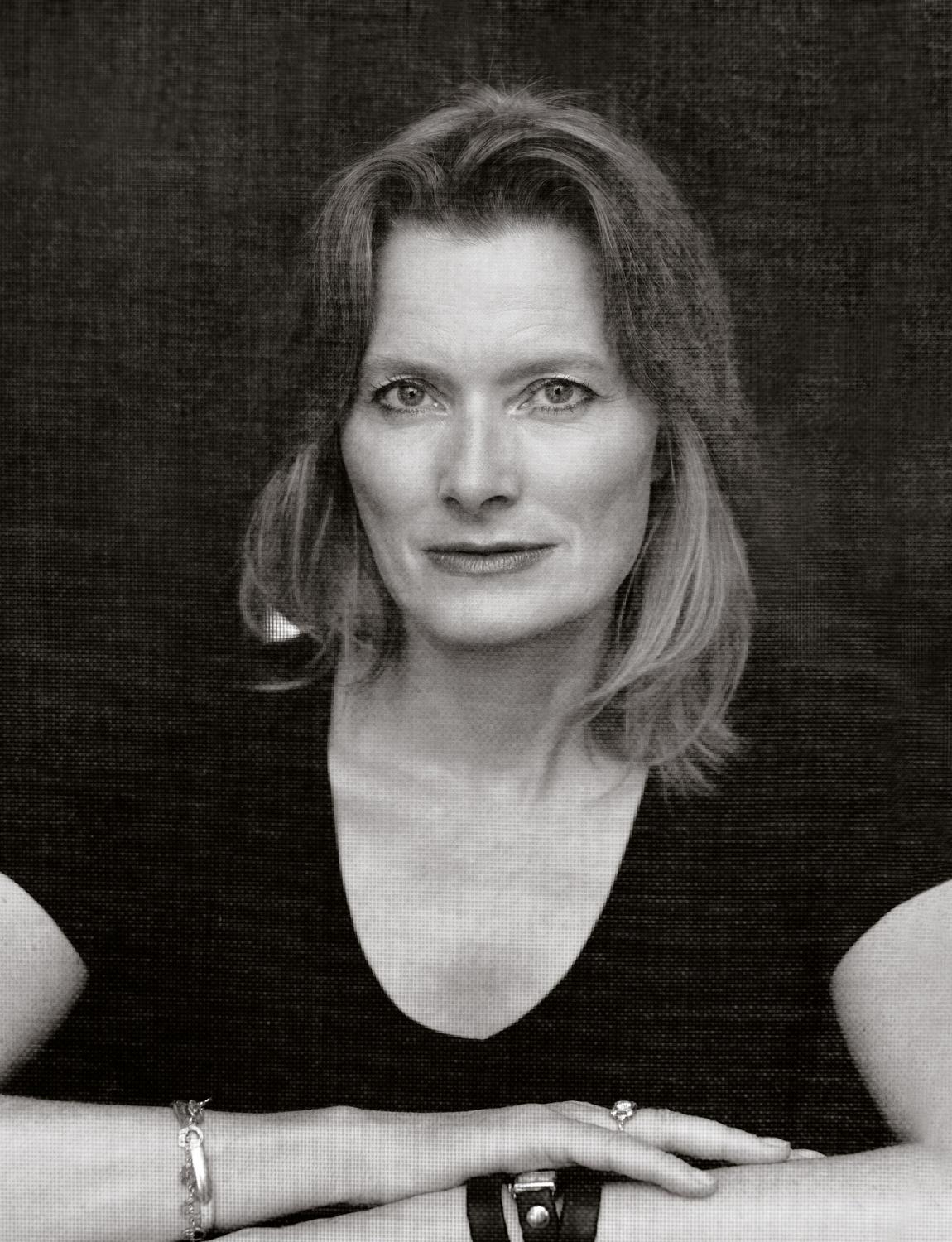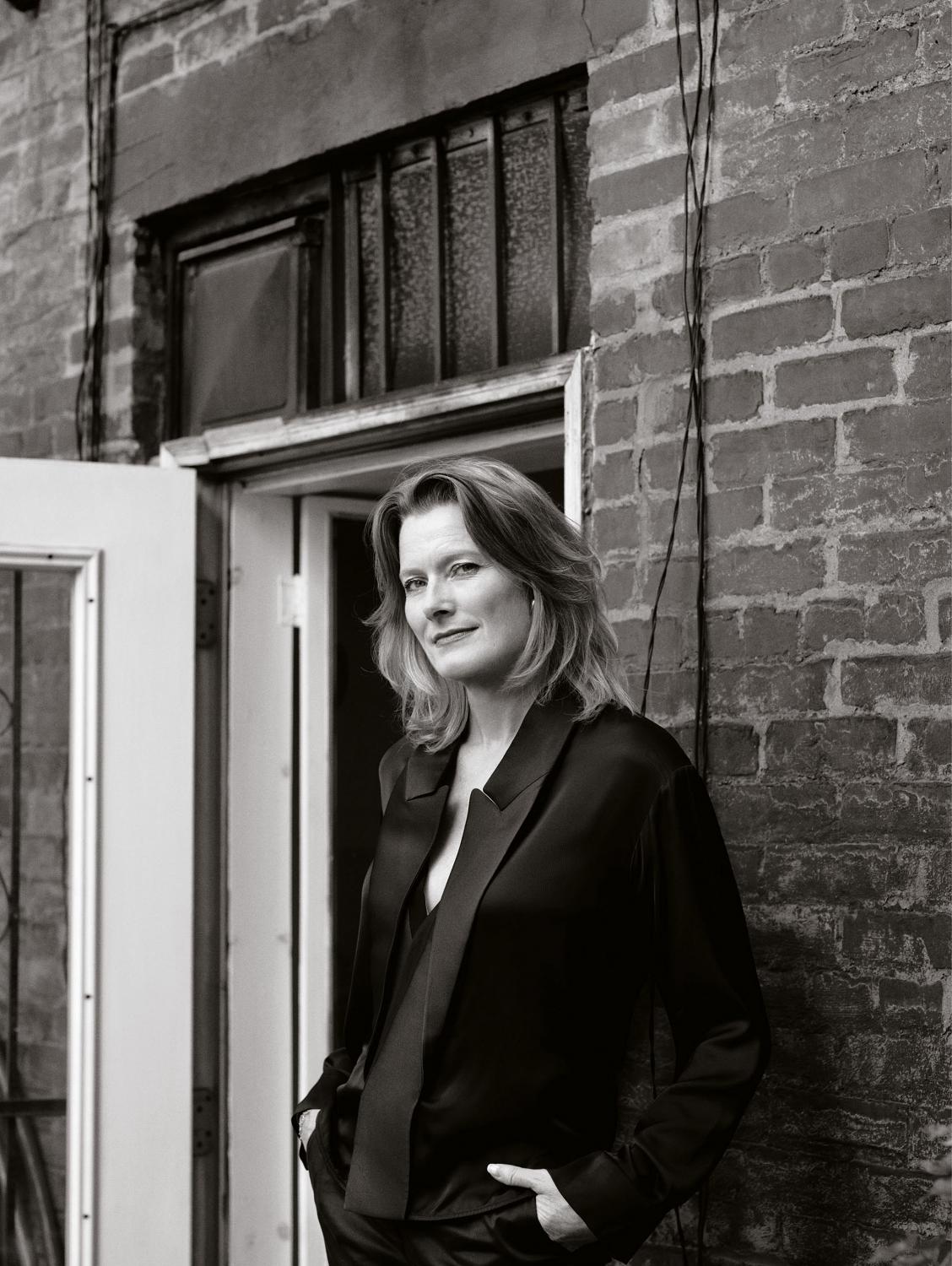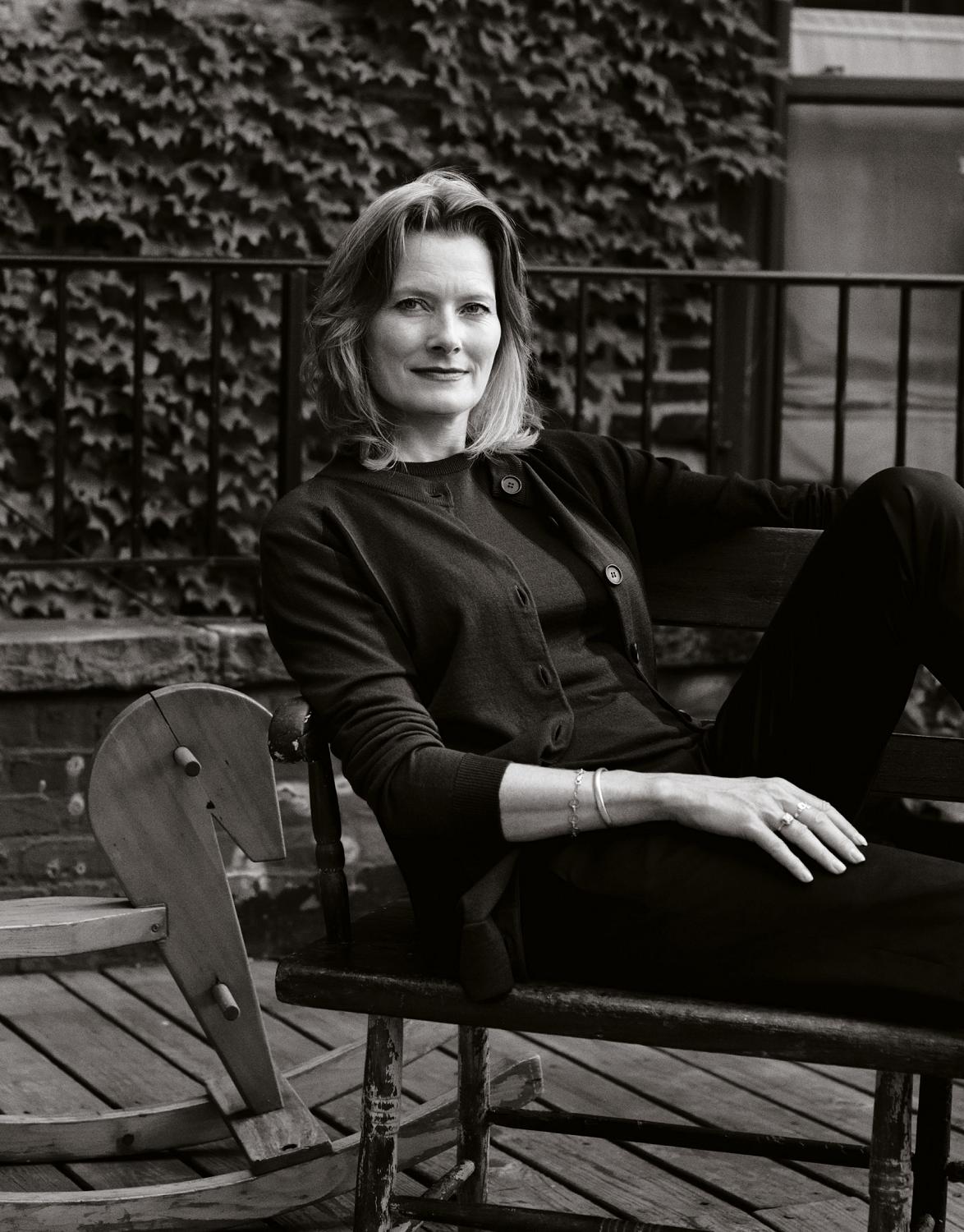Jennifer
Egan
The great American novelist everybody’s reading

Issue n° 4, Autumn & Winter 2011
Jennifer Egan’s latest novel, a satirical dissection of America’s decaying music industry, has won her this year’s Pulitzer Prize and put her name at the top of the bestseller lists. She’s a daring writer who’s brave enough to eschew the maxim about writing what you know (race, sexuality – she’ll go there); in fact, she’d rather write about men than herself.
She looks like a movie star, and her newfound fame has got her invited to a whole lot of celebrity parties and events, which might, she says, be fabulous. But she’s a happy workaholic who’d rather be at her desk in Brooklyn with her cat on her lap.
Before meeting her, I’d built up a specific idea of what Jennifer Egan might be like. Three chapters into her masterpiece fifth book, A Visit From the Goon Squad, I’d fallen in love with this favourite new author. An avid Google search began that ended up with me knocking on her door at 1pm on a blistering New York Tuesday afternoon. She didn’t disappoint.
The writer I’d researched via her ultra-evolved website, jenniferegan.com, appeared to be the kind of stylish New York intellectual I admire but find slightly intimidating. Apart from novels, Jennifer turns out exemplary journalism on subjects united by their zeitgeisty relevance.
Click on the ‘non-fiction’ button, and there’s a New York Times Magazine cover story that dealt with bipolar disorder in children and went on to rattle an open nerve in 2008; a 2002 piece from American GQ that began with the incendiary declaration ‘Unlike a lot of people in my generation, I was never all that interested in Madonna’; and a searing portrait of youthful homosexual loneliness dating from 2000 (‘Lonely Gay Teen Seeking Same’, another New York Times Magazine cover).
Jennifer struck me as a thoughtfully provocative sort. She doesn’t have to shout loudly to make her point. She does it elegantly. Her website has no screaming Twitter feed; there’s no perceptible hankering for personal publicity. The reviews of her novels in her online press cuttings portfolio exude the quiet respect of her peer group. The portraits accompanying her work depict a gorgeous blonde with movie-star bone structure. At age 48, she has a touch of Michelle Pfeiffer about her.
She opens the huge door to her impressive brownstone in Fort Greene, Brooklyn, in a vest and a long skirt, with pink-framed sunglasses pushed onto her forehead. Jennifer and her husband bought in the suburb pre-gentrification. Evidence of their two sons, eight and ten, is everywhere: a cello and a piano strewn with sheet music in the open-plan living room; open cereal packets in the ’70s-looking kitchen, complete with eye-level cooker; early-learning art on torn sheets of paper taped all over the back porch wall. The family cat, a rescue of indeterminate breed with a sleek bronze coat and smudged black face, saunters through the house.
April 2011 was a mixed month for Jennifer Egan. To her surprise, she won the Pulitzer Prize for fiction for A Visit From the Goon Squad. She also lost her other cat under the wheels of a passing car. It was, she notes, the first time her sons had faced mortality. This seems to be a more important issue for her than winning the prize.
Diamond was the cat who would sit on Jennifer’s lap while she was writing Goon Squad, in longhand (her journalism is written on a computer). Diamond was the affectionate one. The remaining cat is more aloof. Before arriving for a delicious homemade lunch in the back garden (toasted bagels with four fillings – tuna mayonnaise, egg mayonnaise, pesto, and coronation chicken – a lightly dressed leaf salad, strawberries and iced coffee), one thing I hadn’t expected to find in the life of Jennifer Egan was a cat called Cuddles.
“I know, I know,” she says, with a note of embarrassment at the schmaltzy name. “One of the boys named it.”
Five times in a two-hour lunch, Jennifer excuses herself to scout around for the cat. She’s had wire fencing erected at the back of the garden to ensure its safety. But still, you worry.
“Cuddles,” she calls gently into the greenery, at regular intervals. “Cuddles.”
“This happens a lot when you try to write satire in America – by the time the book comes out, it’s already real.”
A friend had recommended Goon Squad to me with the caveat, “It won the Pulitzer Prize, but don’t let that put you off.” I tell Jennifer this. “That’s so hilarious!” she says. “It’s true. We’re all appalled by the idea of, you know... No one wants a lesson. You want to have fun. I feel that so keenly. All the best stuff is fun. I feel like there’s no excuse for it not being. This is not to say that it’s going to be all the time. There can be nuances and gradations.” Goon Squad is not a frivolous novel. “To me, sheer frivolity is not fun either. It gets very dull.”
The book is a bold satire on the crumbling American music industry. Written as a non-chronological series of episodes, it has a search engine-like quality to the way it deals with subjects including technology, PR, journalism and the possible futility of the modern relationship – often in touching and uncomfortable ways. It is frequently funny. Its innovative touches – not least the PowerPoint presentation that acts as its penultimate chapter – have been controversial.
By the time it had reached the shelves, however, one part of Goon Squad was no longer merely satirical. A scathing episode involving an African dictator calling on the services of a once-hot New York PR to deflect attention from, uh-huh, genocide had been mirrored in real life by Gaddafi’s hiring of spin doctors. “This happens a lot when you try to write satire in America,” Jennifer says. “The reality catches up with you and takes over before you know it. Publishing takes so long. By the time the book comes out, it’s already real.”
When I mentioned Goon Squad to an American friend, a wealthy executive in the music industry, he begrudgingly acknowledged its genius with the snippy remark, “And she doesn’t even work in music, you know?” But then, everyone who reads the book comes to the conclusion that there must be some element of memoir involved.
Jennifer Egan was born in Chicago in 1962 and grew up in San Francisco with her mother and stepfather during the rise and fall of Haight-Ashbury. Her father stayed in Chicago, where his family had strong links to Irish Catholic policing on the city’s South Side (“a total Irish-American cliché”). She wears a claddagh ring and bracelet in deference to this lineage, if not the religion she was brought up in. She says her father would have been a priest were it not for the Catholic Church’s insistence on celibacy. Her paternal grandfather was a tough character, a cop and security aide who acted as President Truman’s beef when he visited the city. When she was a child, her grandfather let her hold his gun (“So nice”).
Originally, Jennifer wanted to be an archaeologist, but she went to Pennsylvania State University to study major English literature instead. There, she met her husband, David Herskovits. They dated for a long time before marrying and married a long time before having children. They are both, she says – and this cannot be a coincidence – workaholics. “Before we had kids, the passion for work meant six, seven days a week for both of us. There was just a sense that work was a part of life, always. They were one and the same.”
Her husband is an off-off-Broadway theatre director who specialises in radical updates of classics such as Shakespeare’s Hamlet and Goethe’s Helena. She says he’s great at it. He is Jewish, and though their two children are being raised in the faith, Jennifer describes herself as agnostic.

Here, Jennifer wears a black silk tuxedo-lapel blouse by STELLA McCARTNEY, also with her own trousers. In the opening image and photographed through a screen window in New York City, where she lives, Jennifer‘s wearing a black cotton V-neck T-shirt by CHRISTINA LEHR. The jewellery, pictured throughout, is her own.
By the time she published her first novel, The Invisible Circus, in 1995, Jennifer Egan was already an established voice in American journalism. The book was turned into a film starring Cameron Diaz, but it passed without notice. A collection of short stories, Emerald City and Other Stories, was published in 1997. Her second novel, Look At Me (2001), treated the fashion industry as Goon Squad treats music, by peeling back the layers of artifice one at a time. It was followed by her first bestseller, a wild gothic romance titled The Keep (2006).
She has received numerous plaudits, including a Guggenheim Fellowship and a National Endowment for the Arts fellowship in fiction. Prior to the Pulitzer, Goon Squad won the 2011 National Book Critics Circle Award for fiction as well as this year’s Los Angeles Times Book Prize. Jennifer is also listed in Time magazine’s 2011 Time 100.
A Pulitzer – a trophy surely all novelists fantasise about scooping at some point – is no guarantee of success, however. “If you look at the list of Pulitzer winners, there are people on there that you’ve never heard of,” she says, “so one has to be careful not to get carried away. You know, it feels like the merging of one’s small and flawed self with this iconic brand, but at the same time, everything’s in flux. You’ve got to keep on moving forward. One of the strangest things about winning a prize like this is the sense that a crazy wish has been fulfilled. It doesn’t seem possible because of course a crazy wish is set up as something that cannot be fulfilled. So to have it fulfilled involves a kind of cosmic rearrangement. Which is odd.”
Jennifer had always wanted to write about music. Her last musical epiphany was sparked by Eminem’s poorly reviewed Recovery album. “I have gotten pretty enamoured with Eminem. My older son loves him. At first I thought, ‘Oh, you must be kidding.’ He’s so childish, and it’s so easy to mock him, because he certainly can be very immature in his attitudes about women and gay people. But in some ways that’s so familiar and so silly that it’s easy to brush off. His wordplay is kind of incredible, though. I just really loved Recovery. I felt like it was a vision of someone coming out of a troubled situation. He explored it in a variety of ways.”
She continually asked her editor at The New York Times Magazine for a music assignment, but they already had Lynn Hirschberg. “Lynn is a fantastic music writer. She had millions of connections and great ideas. All I could think of were certain pieces that she’d already written.” Like the one she did in the aftermath of the shooting of Tupac Shakur. “That weird commingling of gunplay and music production. Amazing.”
“The further I can get from my own experience, the looser I am and the easier it is.”
In 1999, Jennifer got her chance. She was commissioned to follow a pair of identical-twin female rappers called Dyme. “Their album was just about to be released, and I was supposed to follow them through that process. I was in absolute ecstasy. Finally. Oh my God, there’s this funny story attached to this. It’s embarrassing to me, but it’s far too good to resist. There was a Notorious B.I.G. album being released, and I went to the party with these women. It was a very distinct kind of subcultural experience, where I was certainly not on the inside. It was at a place in the Flatiron district. Biggie’s music was playing very loudly. I’m not sure I saw another white person there. But I love subcultures, the sense that there’s a kind of technical knowhow particular to that group of people. So I approached this guy with a question that seemed very reasonable under the circumstances. ‘Where’s Biggie?’ But of course it was a posthumous release. This man had the unfortunate job of turning to me and saying, ‘Biggie’s dead.’ It was just unbelievable.”
She laughs the laugh of the shamed. Her piece never made it into print, but she says the Dyme sisters were “fabulous”.
Reading Goon Squad reminded me how much better the best women writers are at writing about pop music than their male peers. Women feel the warmth and see the hilarity of it. They don’t go searching for the virtuosity, or care which other records the producers have mixed. They love it for it.
In spite of its subject matter, the book was not initially marketed to music fans. “I’m ashamed to say this, but we never really reached out to the music world at all in terms of marketing or PR. I had no interviews with music magazines. I think that was an oversight on all of our parts – we just didn’t think that they would care. But maybe it worked out for the best this way. They found it on their own.” Nor did she anticipate the age range of the audience. “When I was working on it, I thought: This is a book that’s for people of 40 and over, plain and simple. It’s about time and change. What 20-year-old cares about that? And yet I’ve been going to high schools talking to kids who are reading the book. Seventeen-year-olds. Why? It’s shocking to me.” But 17-year-olds have YouTube. They know what punk is; they’ve seen it. They don’t have to go to thrift stores to find out who the Buzzcocks are.

Jennifer wears a green and black wool cardigan and crew-neck sweater, both by CHLOÉ, with her own trousers.
Death and success are closely aligned in Goon Squad. Because it’s about what happens to people, it can be cruel. When I remark that a child who appears in its first half seems slightly demonic, she asks, “Do you have kids? Because they are like that, I’m sorry to tell you.” But the book can be kind, too. Jennifer’s pen portrait of a 19-year-old boy not yet ready to accept that he’s gay is incredibly touching, I tell her. “That’s so nice to hear,” she says. “Thank you. There’s so much fear of stepping on toes.” In The Keep, she never referred to her non-white characters’ ethnicity. Only she knew. “I guess with this one I just decided, if people are going to be mad, then let them be mad. I’m moved to do this. My weakest point is writing about myself and my own life – I hate doing it. The further I can get from my own experience, the looser I am and the easier it is. It’s why I often write about men, I think. Then I know it’s not me.”
Jennifer says she thinks she is probably the person she wanted to become. “I wasn’t someone who had a vision of myself as a wife and mother. In fact, I think I recoiled from that, because I saw it as a kind of domestic prison. I wanted to be an actor in the world, not someone who kept the nest warm. I had a very charismatic stepfather. He was someone who everyone listened to when he spoke. And I thought, ‘I want to be like him. Not his wife.’ So I wasn’t sure if being a mother would fit into that. I guess what I’m saying is that when I see myself yelling next to my son’s baseball field, I’m amazed to see myself in that role. That’s the biggest surprise.”
Her next novel will be set, she thinks, in 1940s New York. A television series of Goon Squad may be made; HBO has optioned it. But Jennifer says she’ll have nothing to do with the TV adaptation. “Why would I? I’ve never worked in TV.” I try to think of comparable female New York-based writers whose work translated well on the screen and remember Tama Janowitz, whose epochal collection of short stories Slaves of New York (1986) was adapted into a film based on a script she originally wrote at Andy Warhol’s request. Perhaps Janowitz’s celebrity-fuelled success story was particular to its time, though – the bright starlet with her unkempt hair and Katherine Hamnett wardrobe, papped at glitzy downtown parties, sandwiched cheek-to-cheek between Bret Easton Ellis and Jay McInerney.
Is Jennifer becoming a star? I ask. “Not that I can detect.” Would she detect it if she were? Does she get invited to the kind of parties she once didn’t? “Not discernibly.” Or did she get invited to exciting parties anyway? “I may have gotten invited to exciting parties, but since I almost never go, I wouldn’t know.”
We discuss whether the idea of the literary star’s now more relevant to men. “I don’t know whether that’s true. It’s just hard to think of a woman it’s happened to. Tama Janowitz, definitely. Donna Tartt, of course. Speaking from the gut, my guess is that having been such an out-there personality, it came back to bite Tama later. Now, was that purely because she’s a woman? I have no idea. But there’s a distrust of stardom in the literary world. We’re not only fascinated by stars, but we demand that they continue to be made and then enjoy ripping them down again. It’s a very strange process.”
Hair: Kevin Ryan at Art and Commerce. Make-up: Francelle at Art and Commerce. Photographic assistance: Nyra Lang. Production: Nikki Stromberg at MAP.
This profile was originally published in The Gentlewoman n° 4, Autumn & Winter 2011.